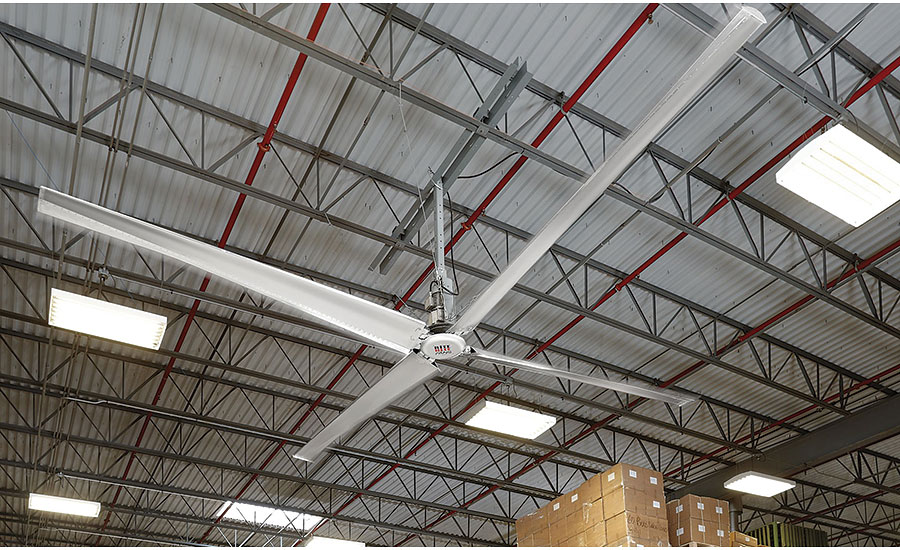In recent years, an increasing number of industrial facilities have added high-volume, low-speed (HVLS) fans to make their HVAC systems work more efficiently. There is also a growing awareness of the health and safety benefits of HVLS fans, whose cool breezes can not only help prevent various forms of heat stress, but also make workers more productive, alert, focused and, ultimately, safer.
Some facility managers worry that the installation of these large, ceiling-mounted fans could have a safety downside – by inhibiting the effectiveness of a facility’s sprinkler systems in the event of a fire. The interaction between HVLS fans and sprinkler systems has certainly been of interest to the National Fire Protection Agency (NFPA), who conducted a multi-part study to determine if the operation of these fans could negatively affect the performance of emergency fire sprinklers.
Fortunately, results of that study led the NFPA Research Foundation to conclude that HVLS fans are safe to use in conjunction with fire sprinklers, as long as the guidelines NFPA subsequently developed are followed.
Before looking at those guidelines, let’s review the types of heat challenges HVLS fans address and how they do it.
Combatting heat stress
The mildest forms are heat fatigue (in which workers begin to lose concentration and perform erratically) and heat rash (which occurs when sweat ducts get plugged and skin becomes agitated and painful). Heat stress may also cause heat cramps, typically in the larger muscles used during work like back, arms, legs and abdomen.
Heat exhaustion, heat syncope (fainting) and heat stroke are among the most serious types of heat stress disorders. Heat syncope usually happens because of a pooling of blood in the lower extremities and dilated vessels of the skin, leading to low blood pressure and sudden unconsciousness. Heat exhaustion can occur on its own or as a prelude to fainting. Common symptoms are similar to heat fatigue, but more severe including diarrhea, nausea and disorientation. Heat stroke is the most serious heat stress disorder and can be life-threatening. It occurs when the body’s systems of temperature regulation fail and body temperatures rise to critical levels. It can be marked by an absence of sweating, as well as confusion, fainting and/or convulsions. Hospitalization is a must for anyone who suffers a heat stroke.
Keeping cool with HVLS
Smaller, floor-mounted fans can help in limited areas, but their high wind speed can cause problems; noisy operating levels introduce another stress-inducing factor; and they consume high amounts of electricity. HVLS fans use relatively little energy and provide a gentle, quiet breeze.
Various studies have estimated that a 2 to 3 mph air speed creates a cooling sensation of 7 to 11 degrees F. To put this in perspective, the effective temperature of an 84-degree F environment can be dropped to 73 degrees F by adding a fan moving air at 3 mph. Studies also show that air moving faster than 5 mph can be disruptive and provides little, if any, added cooling benefit.
Technically advanced HVLS fans can move large volumes of air over an area up to 22,000 square feet. A single HVLS fan can replace as many as 20 floor fans, reducing clutter on the ground and lowering the chances of an accident. By mixing air, HVLS fans also help air-conditioning systems work more efficiently, allowing them to be operated at a lower set point.
Integrating HVLS with BMS
The most advanced HVLS fans can be linked into networks of up to 18 fans and run off of a single controller. That controller allows for independent speed adjustments, scheduled start/stop times and the ability to start/stop based on preset temperature settings.
An optional Ethernet port allows the system to be accessed via a remote device so they can be controlled via a smartphone or other mobile device. They can be programmed into a building maintenance system (BMS) and connected to other infrastructure equipment such as exhaust fans. A “fire stop” option triggers the BMS to automatically turn off the HVLS fans and activate sprinklers in the event of a fire.
NFPA testing and guidelines
The NFPA Research Foundation established guidelines for the installation and use of HVLS fans in buildings with automatic sprinklers. The testers concluded that HVLS fans, without additional fire, smoke, or heat detecting equipment, did not prevent the sprinkler systems from meeting the established “pass” criteria for any of the tests.
The primary concerns NFPA sought to resolve were if a sprinkler would be obstructed by an HVLS fan and if the air distribution generated by an HVLS fan negatively impacted the sprinkler’s ability to put out a fire.
The resulting guidelines – mostly based on the size and placement of the fan – can be found in NFPA 13: Standard for the Installation of Sprinkler Systems. Most notably, HVLS fan diameters should not exceed 24 feet, the fans should be centered between adjacent sprinklers, and that there is a three-foot clearance between the sprinkler deflector and fan blade.
The study was sponsored by six risk management companies and three HVLS fan manufacturers and was comprised of a series of ten full-scale fire tests held at FM Global and UL Laboratories, under the supervision of AON Fire Protection Engineering.
The information herein is provided as a general reference regarding the use of the applicable product(s) in specific applications. This information is provided without warranty. It is your responsibility to ensure that you are using all mentioned products properly in your specific application and in accordance with all laws and regulations.






